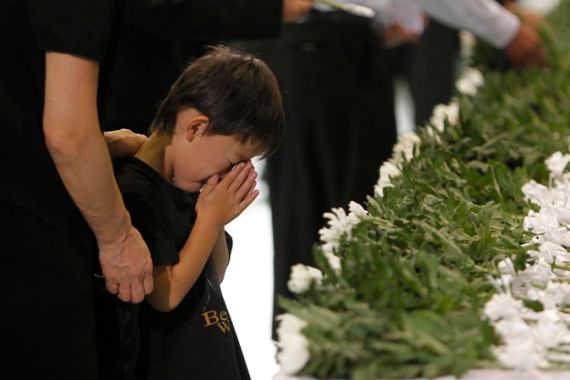Japan mourns disaster victims six months on
Ceremonies take place in Japan to commemorate six months since northeast coastline was devastated by quake and tsunami.

 |
|
People attend a memorial service for victims of the March 11 earthquake and tsunami in Minamisanriku [Reuters] |
Ceremonies to mourn the dead and rallies against nuclear power are taking place across Japan as the nation marks six months since the March 11 earthquake and tsunami that killed thousands of people.
Silent prayers were offered at 2:46 pm, the moment the quake struck six months ago, triggering a tsunami that devastated swathes of Japan’s northeastern coastline and sparked a disaster at the Fukushima Daiichi nuclear plant.
Keep reading
list of 4 itemsAfter the Hurricane
World’s coral reefs face global bleaching crisis
Why is Germany maintaining economic ties with China?
Al Jazeera’s Steve Chao reporting from Ishinomaki, said the occasion was sombre as survivors returned to mark the loss of loved ones.
“While people are trying to move on, progress has been slow but steady. The government has cleared some 23 million tonnes of rubble but what is troubling for many social workers is the psychological trauma that remains,” our correspondent said.
About 2,000 people observed a moment’s silence at a public gymnasium in Minamisanriku in memory of 900 people who were killed in the disaster, which also destroyed 60 per cent of the town’s buildings.
It was one of a string of events planned along Japan’s northeastern coast which was ravaged by huge waves.
Such was the destruction caused by the quake that some still think life is not yet back to normal.
Hidetada Matsuda, 71, of Sendai City, who was at a jazz festival with his wife, Hiore, said he was not even sure that the event would take place.
“I came to listen to the music played by people from the disaster areas,” said Matsuda.
Although Sendai City was certainly considered a disaster zone, Matsuda said that after he had visited a friend in the harder-hit Watari, a town north of Sendai, he did not consider his own city to be so hard hit.
“I was struck by how much debris there still is,” he said as the Swing Dolphins, a junior jazz band from Kesennuma, another hard-hit coastal town, performed on stage.
Challenges for PM
Yoshihiko Noda, the Japanese prime minister, on Saturday travelled to ravaged Miyagi and Iwate prefectures for the first time since taking office nine days ago, when he replaced Naoto Kan who resigned amid criticism over his handling of the crisis.
The government has been criticised for its response to the disaster, amid suspicions it underplayed the full scale of the nuclear crisis, and as political infighting overshadowed recovery efforts.
An anti-nuclear protest was staged to coincide with Sunday’s events. Rallies were also planned in Tokyo and other cities.
Yoshida Norihiko, a 42-year-old massage therapist from Fukushima, joined a protest that ran through one major street that intersected with the jazz festival in Sendai City.
“People in Tohoku [the region hit hardest by the earthquake and tsunami; it includes Fukushima] are not so expressive, but when I heard about this protest, I thought it was a good chance to say something today,” he said.
As a Fukushima resident, Norihiko said he was unhappy with the government’s response to the nuclear meltdown at the Daiichi plant there.
“In the six months since earthquake, there’s nothing that the government has done that I’m happy about,” Norihiko told Al Jazeera’s D. Parvaz, reporting from Sendai City.
The raging wall of water unleashed by the record 9.0 magnitude quake left 20,000 people dead or missing and triggered the world’s worst nuclear crisis since Chernobyl in 1986.
Rebuilding the muddy wastelands of the northeastern Tohoku region is expected to cost hundreds of billions of dollars and take up to a decade.
Areas close to the Fukushima Daiichi nuclear plant may be uninhabitable for longer.
Radiation fears are a daily fact of life after cases of contaminated water, beef, vegetables, tea and seafood due to the Fukushima accident.
The government has been at pains to stress the lack of an “immediate” health risk.
The towering wall of water battered cooling systems at the plant, 220km northeast of Tokyo, leading to reactor meltdowns and the spewing of radiation, forcing tens of thousands to evacuate.
A day ahead of the anniversary, survivors in Soma in Fukushima prefecture held a memorial ceremony for the 459 people dead or missing from the city.
“I promise to address the reconstruction with all my strength and all my heart,” said Yuhei Sato, Fukushima’s governor, as he stood in front of a stage full of white chrysanthemums.
Hundreds of paper lanterns were released into the sky there at dusk on Saturday, symbolising the souls of those lost in the disaster.